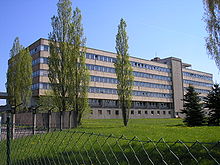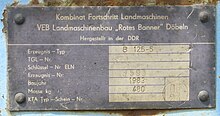Combine
A combine ( Latin combinatus 'united', from Russian Комбинат ), sometimes also called a large combine, is an amalgamation of industrial companies that work closely together in terms of production to form a large company in socialist states. The combine in socialist states was the counterpart to the corporation in capitalist states.
Combination term in the GDR
In the central administrative economy of the GDR , a combine was a corporation-like , i.e. horizontally and vertically integrated group of state- owned enterprises (VEB) with a similar production profile. Forerunners were the associations of state-owned enterprises (VVB) since 1948 . In several centralization spurts from the end of the 1960s, the VVB structures were transferred to Kombinate.
Production, research, development and sales of one branch were brought together in the combine. Their structure should serve a greater rationalization and an improved, centralized control of the production processes. The combine was managed from a parent company, which was mostly the largest VEB in the combine. Within the system of the GDR economy, every combine had the plan to also produce consumer goods for the needs of the population; the target was at least 5% of its total production. The heads of the combines were accountable for fulfilling the state plan requirements .
School combinations existed in the GDR around the beginning of the 1960s . These were located in rural areas and represented larger, centralized schools in the form of a polytechnic high school as the successor to smaller village schools. The pupils were taken to school every day by public transport or some of them stayed overnight in an attached boarding school during the school week.
In parlance in the GDR , the word combine was also used for company associations in socialist countries .
Combine management

At the head of the combine was a General Director (GD), who was often also the director of the parent company. The combine management was formed by further deputy general directors, specialist directors and the heads of the company party organizations and company union leaderships . General directors of the important combines were high nomenclature cadres , that is, their appointment had to be confirmed beforehand by the Central Committee of the SED . The politicized structure of the East German planned economy meant that the general directors were predominantly SED cadres. In the hierarchy of the GDR economy, they were formally directly subordinate to the responsible minister and the responsible department in the Central Committee of the SED, and in the case of district-managed combines, to the corresponding offices at district level. Important decisions were made directly by the Central Committee secretary for economic issues (from the mid-1960s this was Günter Mittag ). Within the combine, the general director, as the head of individual responsibility, had considerable rights of disposal (e.g. to make his own investment decisions). Among other things, he managed and controlled the directors of the individual VEB.
Types of combines
There were around 167 centrally managed combines and around 90 district-managed industrial combines, which were set up as a kind of "collection point" for smaller "medium-sized" companies, especially after the last wave of nationalization in 1972.
In Kombinat Fernmeldebau of Deutsche Post , the telecommunications building authorities and other Baueinrichtungen Deutsche Post were summarized. This combine was part of a state institution, i.e. an authority.
Structure example
- Main company: VEB factory for technical glass Ilmenau - headquarters of the combine management
-
VEB Thermometerwerk Geraberg
- VEB measuring instruments Schönbrunn
- VEB Glaswerke Stützerbach (Westglas)
- VEB Rosalinglaswerk Ilmenau
- VEB Glaswerk Gehlberg
- VEB Rennsteigglas Schmiedefeld am Rennsteig
- ...
-
VEB Thermometerwerk Geraberg
In total, the Ilmenau Glass Combine had around 115 operating parts, which were organized in 18 larger VEBs. The total number of employees in all plants was around 13,000.
List of important combines in the GDR
A distinction should be made between the designations that after the early formations of the combine, the name of the combine was mentioned first and the company (and, if applicable, other parts of the company) added; this occasionally led to extremely long names. Before the end of the GDR, the company was first named and added to which combine it belonged or which company it was a parent company.
For example:
- VEB Autobahnbaukombinat (ABK)
- Combine VEB NARVA "Rosa Luxemburg"
- VEB Bandstahlkombinat " Hermann Matern ", Eisenhüttenstadt with headquarters in the VEB Eisenhüttenkombinat Ost (EKO), Eisenhüttenstadt
- VEB Kombinat Cotton, Karl-Marx-Stadt
- VEB Construction and Assembly Combine Coal and Energy , Hoyerswerda (largest construction company in the GDR)
- VEB Bau- und Montagekombinat (BMK) Magdeburg
- VEB Bau- und Montagekombinat Chemie , Halle
- VEB Bergbau- und Hüttenkombinat "Albert Funk" , Freiberg , (lead, silver, zinc, tin, nickel, tungsten and other metals)
- VEB Chemiekombinat Bitterfeld (CKB) , Bitterfeld
- VEB Chemical Combine "Otto Grotewohl" , Böhlen
- VEB Chemieanlagenbau Leipzig-Grimma (CLG)
- VEB Kombinat Deko, Plauen
- VEB Deutfracht shipping company , Rostock
- VEB Deutrans Internationale Spedition , Berlin
- VEB Elektro-Apparate-Werke, parent company Elektro-Apparate-Werke Berlin-Treptow "Friedrich Ebert" (EAW), Berlin-Treptow
- VEB Feinkeramik, parent company Kahla with, among others, the Colditz and Ilmenau porcelain factories
- VEB Fotochemisches Kombinat , Wolfen ( ORWO brand )
- VEB Gaskombinat Black Pump , Black Pump
- VEB Industriebaukombinat (IBK) Magdeburg
- VEB IFA -Kombinat Nutzkraftwagen, Ludwigsfelde
- VEB IFA-Kombinat trailer, Werdau
- VEB Kombinat progress agricultural machinery , Neustadt
- VEB IFA-Kombinat PKW, Karl-Marx-Stadt
- VEB IFA-Kombinat for two-wheeled vehicles, Suhl
- VEB Kombinat Automation and Plant Engineering (KAAB), Berlin
- VEB Kombinat construction machinery, complete systems and earthmoving machines (Baukema), Leipzig
- VEB Carl Zeiss , Jena
- VEB Kombinat Chemical Works "Walter Ulbricht" , Leuna
- VEB Kombinat Chemische Werke Buna , Schkopau
- VEB Kombinat data processing
- VEB Kombinat Elektromaschinenbau (VEM), Dresden
- VEB Kombinat Electronic Components (KEBT), Teltow
- VEB Kombinat garden tools Steinbach-Hallenberg, Steinbach-Hallenberg
- VEB Combine Grain Industry
- VEB Kombinat gearboxes and clutches , Magdeburg
- VEB Kombinat foundry plant construction and cast products (Gisag), Leipzig
- VEB Kombinat Household Appliances Karl-Marx-Stadt
- VEB Kombinat wooden toys VERO Olbernhau
- VEB Kombinat Kabelwerk Oberspree , Berlin
- Kombinat VEB Keramische Werke Hermsdorf (KWH), Hermsdorf (Thuringia)
- VEB Kombinat Kraftwerkanlagenbau (KAB), Berlin
- VEB Kombinat Lausitzer Glas , Weißwasser
- VEB Kombinat Lederwaren Schwerin
- VEB Kombinat Leuchtenbau Leipzig
- Kombinat VEB Lokomotivbau Electrotechnical Works "Hans Beimler" Hennigsdorf (LEW)
- VEB Kombinat Luft- und Kältetechnik (ILKA), Dresden
- VEB Kombinat Medical and Laboratory Technology Leipzig
- VEB Combine Microelectronics "Karl Marx" Erfurt
- VEB Kombinat Food and Beverage Engineering (Nagema) , Neubrandenburg
- VEB Kombinat Food and Coffee Halle / Saale (NAKA)
- VEB Kombinat Plasta Werke, Sonneberg
- VEB Combine Plastics and Chemistry, Selva
- VEB Kombinat Pumps and Compressors, Halle
- VEB Kombinat Polygraph "Werner Lamberz" , Leipzig (polygraphic mechanical engineering)
- VEB Kombinat Robotron , Dresden
- VEB Kombinat Rundfunk- und Fernmelde-Technik (RFT), Leipzig (radio-television-sound mechanics)
- VEB Kombinat Eisenbahnfahrzeugbau DDR , Berlin
- VEB Kombinat Schiffbau , Rostock-Warnemünde
- VEB Kombinat Maritime Transport and Port Management
- VEB Kombinat Solidor Heiligenstadt
- VEB Kombinat Spielwaren Sonneberg
- VEB Kombinat spirits, wine and sparkling wine
- VEB Kombinat Sportgeräte Schmalkalden, Schmalkalden
- VEB Kombinat Confectionery Delitzsch
- VEB Kombinat Technical Building Equipment (TGA), Leipzig
- VEB Kombinat TEXTIMA , Karl-Marx-Stadt
- VEB Kombinat Umformtechnik , Erfurt (large presses)
- VEB Kombinat Packaging, Leipzig
- VEB Kombinat Pulp and Paper Heidenau
- VEB Kombinat Magdeburger Armaturenwerke "Karl Marx", Magdeburg
- VEB measuring device factory "Erich Weinert", Magdeburg
- VEB Mansfeld Kombinat Wilhelm Pieck (MKWP) , Lutherstadt Eisleben , (copper, lead, silver, zinc)
- VEB Kombinat Kali , Sondershausen , (potash fertilizers and chemical raw materials, salt, spar products)
- VEB Petrolchemisches Kombinat (PCK) , Schwedt / Oder
- VEB Pharmaceutical Combine Germed
- VEB Qualitäts- und Edelstahl-Kombinat (QEK), Hennigsdorf (e.g. development of the QEK-Junior as a contribution to consumer goods production )
- VEB tire combine Fürstenwalde
- VEB Rohrkombinat Riesa
- VEB Sachsenring , Zwickau
- VEB Schuhkombinat "Banner of Peace", Weißenfels
- VEB Heavy Machinery “Karl Liebknecht” (SKL), Magdeburg
- VEB Heavy Machinery Combine "Ernst Thälmann" (SKET), Magdeburg
- VEB Special Construction Combine Magdeburg (SBKM)
- VEB Schwermaschinenbaukombinat opencast mining equipment, cranes, conveyor systems (TAKRAF) , Leipzig
- VEB Strumpfkombinat ESDA, Thalheim
- VEB machine tool combine "7. October " , Berlin (until 1950 the main factory was called VEB Deutsche Niles Werke , brand NILES)
- VEB machine tool combine "Fritz Heckert" , Karl-Marx-Stadt
- VEB Tool Combination Schmalkalden , Schmalkalden
- various housing combinations (WBK), district (e.g. VEB Housing Combination "Fritz Heckert" Berlin) or regionally-managed, such as B. VE Housing Combination Greifswald
- various energy combines (power plants, distributions, substations)
- various lignite combines (open-cast mines, briquette factories)
- various combines industrial fattening (KIM) , (poultry and egg production, cage production)
- various motor transport combines in the districts (bus and freight transport, freight forwarding)
- VEK Lautex - Upper Lusatian textile companies
Example of a district-managed combine
- Kombinat wholesale goods for daily needs Karl-Marx-Stadt - formed in the early 80s from several wholesale companies (GHG)
Service combines
Service combines such as the VEB service combine in Berlin were not combines in the sense of the above definition, but independent district or district-managed companies that provided a variety of services for the population. Therefore, they were also referred to as combines. They were founded in the 1950s and increasingly in the 1970s. Among other things, they operated numerous complex acceptance points for their services.
Dissolution of the combines
literature
- Reiner Breuer: On the process of the formation of a combine in industry in the GDR at the end of the sixties . in: Yearbook for Economic History 1983/4, Akademie-Verlag, Berlin 1983, pp. 25–51 ( digitized version of the entire yearbook )
- Lothar Fritze : Organizational and Power Structures of Former GDR Combines. Decay processes of the centrally controlled economic units as obstacles or catalysts of the transition to the market economy (= KSPW short study . 110). KSPW, Halle 1995.
- Rohnstock Biografien (Ed.): The Combine Directors: Now let's talk. What can be learned from the GDR economy today , edition berolina, 4th edition, Berlin 2013, ISBN 9783867898133 .
Web links
- Combine directors talk about a project to explore the GDR's economic history
- Extensive list of combines in the GDR (private)
Individual evidence
- ↑ cf. Rita Aldenhof-Hübinger: "Attention, dry cleaning!" Crafts and services in the GDR, in: Documentation Center for Everyday Culture of the GDR eV (ed.): Progress, Norm and Stubbornness, Berlin 1999, ISBN 3-86153-190-9 , p. 105-112.

